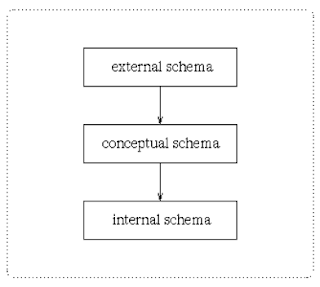A commonly used views of data
approach is the three-level architecture suggested by ANSI/SPARC (American
National Standards Institute/Standards Planning and
Requirements Committee).
ANSI/SPARC produced an interim report in 1972 followed by a final report in
1977. The reports proposed an architectural framework for databases. Under this
approach, a database is considered as containing data about an enterprise.
The three levels of the architecture are three different views of the data:
External -
individual user view
Conceptual -
community user view
Internal -
physical or storage view
The three level database
architecture allows a clear separation of the information meaning (conceptual
view) from the external data representation and from the physical data structure
layout. A database system that is able to separate the three different views of
data is likely to be flexible and adaptable. This flexibility and adaptability
is data independence that we have discussed earlier.
We now briefly discuss the three
different views.
The external level is the view
that the individual user of the database has. This view is often a restricted
view of the database and the same database may provide a number of different
views for different classes of users. In general, the end users and even the application
programmers are only interested in a subset of the database. For example, a department
head may only be interested in the departmental finances and student enrolments
but not the library information. The librarian would not be expected to have any
interest in the information about academic staff. The payroll office would have
no interest in student enrolments.
The conceptual view is the
information model of the enterprise and contains the view of the whole
enterprise without any concern for the physical implementation. This view is normally
more stable than the other two views. In a database, it may be desirable to change
the internal view to improve performance while there has been no change in the conceptual
view of the database. The conceptual view is the overall community view of the
database and it includes all the information that is going to be represented in
the database. The conceptual view is defined by the conceptual schema which
includes definitions of each of the various types of data.
The internal view is the view
about the actual physical storage of data. It tells us what data is stored in
the database and how. At least the following aspects are considered at this
level:
Storage allocation e.g. B-trees,
hashing etc.
Access paths e.g. specification
of primary and secondary keys, indexes and pointers and sequencing.
Miscellaneous e.g. data
compression and encryption techniques, optimization of the internal structures.
Efficiency considerations are the
most important at this level and the data structures are chosen to provide an
efficient database. The internal view does not deal with the physical devices
directly. Instead it views a physical device as a collection of physical pages
and allocates space in terms of logical pages.
The separation of the conceptual
view from the internal view enables us to provide a logical description of the
database without the need to specify physical structures. This is often called physical
data independence. Separating the external views from the conceptual view
enables us to change the conceptual view without affecting the external views.
This separation is sometimes called logical data independence.
Assuming the three level view of
the database, a number of mappings are needed to enable the users working with
one of the external views. For example, the payroll office may have an external
view of the database that consists of the following information only:
Staff number, name and address.
Staff tax information e.g. number
of dependents.
Staff bank information where
salary is deposited.
Staff employment status, salary
level, leave information etc.
The conceptual view of the
database may contain academic staff, general staff, casual staff etc. A mapping
will need to be created where all the staff in the different categories are
combined into one category for the payroll office. The conceptual view would
include information about each staff's position, the date employment started,
full-time or parttime etc. This will need to be mapped to the salary level for
the salary office. Also, if there is some change in the conceptual view, the
external view can stay the same if the mapping is changed.






0 comments